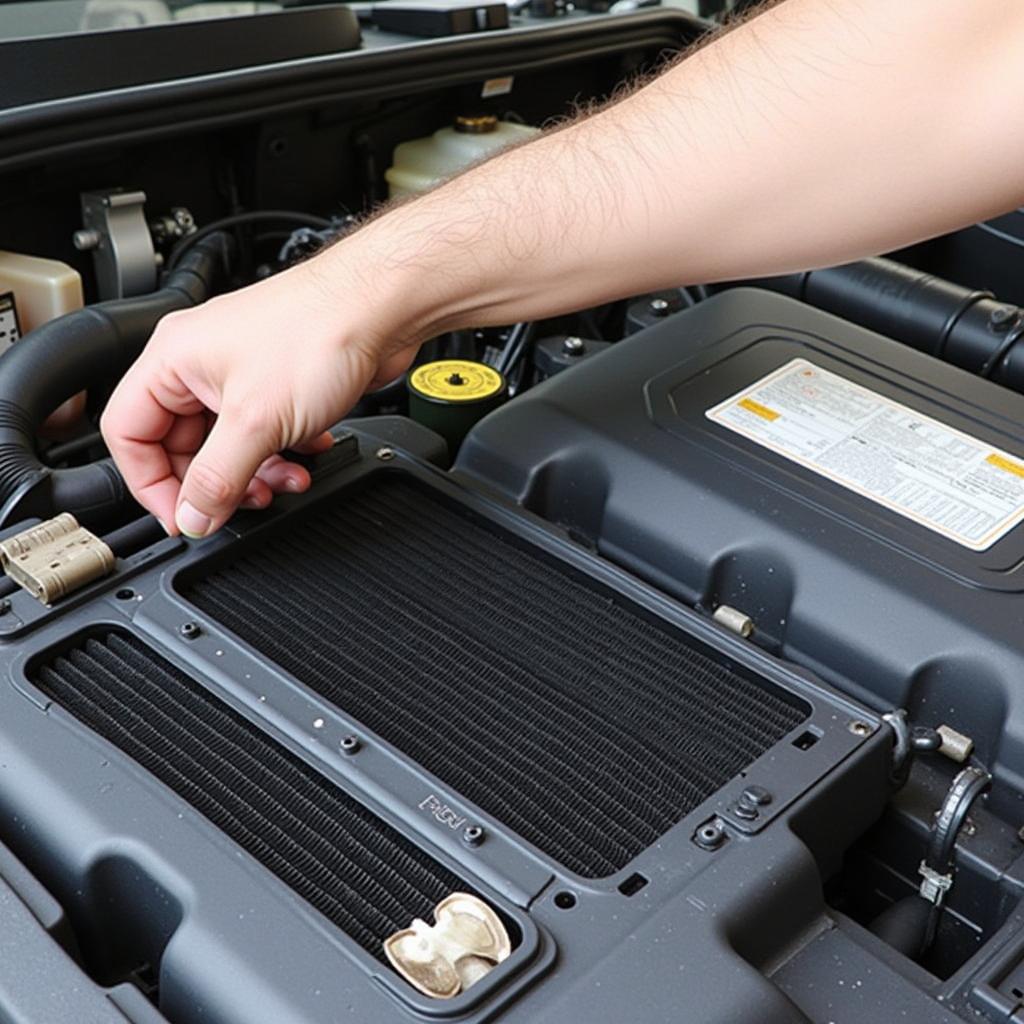A car AC that’s blowing hot air can make summer driving unbearable. This guide will walk you through diagnosing and fixing a car AC that won’t cool, covering everything from simple checks to more complex repairs. Whether you’re a DIY enthusiast or plan to visit a mechanic, understanding the potential issues will save you time and money.
Learning how to fix a car AC system starts with understanding its components. The system uses refrigerant to absorb heat from the cabin, then releases it outside. Several components work together to make this happen, and a problem with any one of them can lead to a malfunctioning AC. ac fixed car may be your ultimate goal, but understanding the underlying problem is crucial.
Common Causes of a Car AC Not Cooling
There are several reasons why your car AC might not be cooling. Some are easy to fix yourself, while others require professional help. Here are some of the most common culprits:
- Low Refrigerant: This is the most frequent cause. Refrigerant leaks can occur over time, reducing the system’s ability to cool.
- Faulty Compressor: The compressor is the heart of the AC system, and if it fails, the refrigerant won’t circulate.
- Clogged Condenser: Located at the front of the vehicle, the condenser releases heat. If it’s blocked by debris, it can’t function efficiently.
- Electrical Issues: Problems with fuses, relays, or wiring can prevent the AC system from working correctly.
- Blend Door Problems: The blend door controls the mix of hot and cold air. If it malfunctions, you might only get hot air.
 Low Refrigerant in Car AC System
Low Refrigerant in Car AC System
Diagnosing the Problem
Before you start any repairs, you need to diagnose the issue. Here’s a step-by-step guide:
- Check the AC Compressor: Listen for the compressor clutch engaging when you turn the AC on. If you don’t hear it, there could be an electrical issue or the compressor itself might be faulty.
- Inspect the Refrigerant Lines: Look for signs of leaks, such as oil residue or frost.
- Check the Condenser: Make sure the condenser fins are clean and free of debris.
- Feel the Airflow: With the AC on, feel the air coming from the vents. If it’s not cold, there could be a problem with the refrigerant, compressor, or blend door.
 Checking the Car AC Condenser for Blockages
Checking the Car AC Condenser for Blockages
DIY Fixes for a Car AC That Won’t Cool
Some AC problems can be tackled at home with basic tools.
- Recharge the Refrigerant: If you suspect low refrigerant, you can purchase a recharge kit and follow the instructions carefully. However, be aware that recharging without fixing the leak is a temporary solution. It is better to find and repair how to fix leaking car ac.
- Clean the Condenser: Use a garden hose or compressed air to remove debris from the condenser fins.
- Check Fuses and Relays: Locate the AC fuses and relays in your car’s fuse box and check for any blown fuses.
“A simple check of fuses and relays can often save you a trip to the mechanic,” says John Smith, Senior Automotive Technician at Smith Automotive.
 Recharging Car AC Refrigerant with a DIY Kit
Recharging Car AC Refrigerant with a DIY Kit
When to Seek Professional Help
If you’ve tried the DIY fixes and your AC still isn’t cooling, it’s time to seek professional help. Complex repairs, such as compressor replacement or leak detection, require specialized equipment and expertise. Don’t hesitate to look for an ac fix near me car.
“Attempting complex AC repairs without proper training can lead to further damage and higher repair costs,” advises Maria Garcia, Lead Mechanic at Garcia Auto Repair. Finding solutions to how to fix my ac in car can be easy with professional help. You may also find where can i get my car ac fixed for cheap.
Conclusion
Fixing a car AC that won’t cool can range from a simple DIY fix to a more complex repair. By understanding the potential causes and following the diagnostic steps, you can identify the problem and determine the best course of action. Remember, a properly functioning AC is essential for comfortable summer driving. For further assistance, connect with AutoTipPro at +1 (641) 206-8880 or visit our office at 500 N St Mary’s St, San Antonio, TX 78205, United States.
FAQ
- How often should I recharge my car AC? You shouldn’t need to recharge your AC unless there’s a leak.
- What’s the average cost to fix a car AC? The cost varies depending on the problem but can range from a few hundred to over a thousand dollars.
- Can I drive my car with a broken AC? Yes, but it’s uncomfortable, especially in hot weather.
- How do I prevent AC problems? Regular maintenance, such as checking for leaks and cleaning the condenser, can help prevent problems.
- What are the signs of a leaking car AC? Signs include oily residue near AC components, a hissing sound, and reduced cooling performance.
- Is it safe to recharge my car AC myself? Yes, if you follow the instructions on the recharge kit carefully.
- How can I tell if my AC compressor is bad? Signs of a bad compressor include loud noises, no cold air, and the compressor clutch not engaging.






Leave a Reply